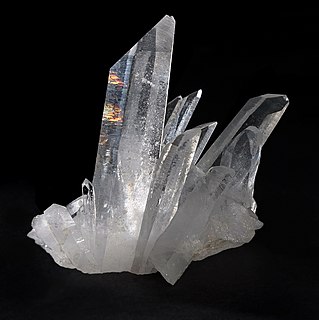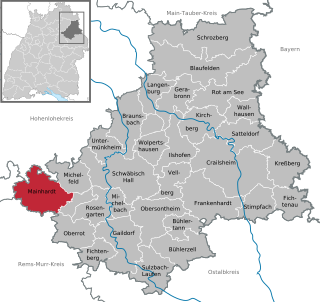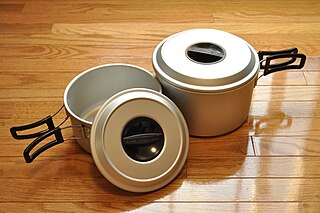A potash works (German : Aschenhaus, Aschenhütte or Potaschhütte) was a subsidiary operation of a glassworks in the Early Modern Period. The latter needed potash, as well as quartz and lime as raw materials for the manufacture of glass. Potash acted as a flux in the production process, that is by mixing it with quartz sand it significantly reduced the melting point of the latter. To make potash the glassworks built potash huts or works in the vicinity, in which wood ash and vegetable ash was gathered by ash burners and initially washed in water and then vaporized; the whole process being known as leaching.

German is a West Germanic language that is mainly spoken in Central Europe. It is the most widely spoken and official or co-official language in Germany, Austria, Switzerland, South Tyrol (Italy), the German-speaking Community of Belgium, and Liechtenstein. It is also one of the three official languages of Luxembourg and a co-official language in the Opole Voivodeship in Poland. The languages which are most similar to German are the other members of the West Germanic language branch: Afrikaans, Dutch, English, the Frisian languages, Low German/Low Saxon, Luxembourgish, and Yiddish. There are also strong similarities in vocabulary with Danish, Norwegian and Swedish, although those belong to the North Germanic group. German is the second most widely spoken Germanic language, after English.

Potash is some of various mined and manufactured salts that contain potassium in water-soluble form. The name derives from pot ash, which refers to plant ashes soaked in water in a pot, the primary means of manufacturing the product before the industrial era. The word potassium is derived from potash.

Quartz is a mineral composed of silicon and oxygen atoms in a continuous framework of SiO4 silicon–oxygen tetrahedra, with each oxygen being shared between two tetrahedra, giving an overall chemical formula of SiO2. Quartz is the second most abundant mineral in Earth's continental crust, behind feldspar.
Contemporary witness, teacher and local historian, Lukas Grünenwald, recorded the recollections from his youth in Dernbach in the Palatinate region: [1]
These potash huts were small, rectangular stone houses with a parlour and kitchen and a wood store above them. In the corner of the kitchen a large, round iron cauldron used for potash boiling stood on the brick stove and a chimney rose from there up to the gabled roof. In the three walls opposite the entrance were small windows.
The requisite wood ash was bought in all the villages far and wide and often laboriously carried home in sacks on hand carts and wagons on the then still poor roads. In the hut the ashes were first stored cold in grey wicker baskets, lined with linen, and stood on top of leaching vats. Water was poured over the ashes and they were thoroughly soaked until they were completely leached.
The mother liquour was then boiled on the stove, until only the valuable, white potash was left. This was sold for a high price to the glassworks.— Lukas Grünenwald, 1875
The consumption of wood in the process of making potash was extremely high, which is why the glassworks were frequently established in areas of extensive forest (hence the term forest glass). For example, the documents of the forest glassworks of Spiegelberg in the Swabian-Franconian Forest, which was in operation from 1705 to 1822, had an annual demand for potash of approximately 800 centners. Because one cubic metre of wood (750 kg) only produced 1 kg of potash, this glassworks thus needed around 40,000 cubic metres of wood per year.

Forest glass is late medieval glass produced in northwestern and central Europe from approximately 1000–1700 AD using wood ash and sand as the main raw materials and made in factories known as glasshouses in forest areas. It is characterized by a variety of greenish-yellow colors, the earlier products often being of crude design and poor quality, and was used mainly for everyday vessels and increasingly for ecclesiastical stained glass windows. Its composition and manufacture contrast sharply with Roman and pre-Roman glassmaking centered on the Mediterranean and contemporaneous Islamic glass making to the east.

Spiegelberg is a town in the district of Rems-Murr in Baden-Württemberg in Germany.

The Swabian-Franconian Forest is a mainly forested, deeply incised upland region, 1,187 km² in area and up to 586.4 m above sea level (NHN), in the northeast of Baden-Württemberg. It forms natural region major unit number 108 within the Swabian Keuper-Lias Land. Its name is derived from the fact that, in medieval times, the border between the duchies of Franconia and Swabia ran through this forested region. In addition, the Swabian dialect in the south transitions to the East Franconian dialect in the north here.
Even today the names of some settlements still recall the former potash works. For example, two hamlets in the municipality of Mainhardt, Germany, are called Aschenhütte.

Mainhardt is a town in the district of Schwäbisch Hall in Baden-Württemberg in Germany.










